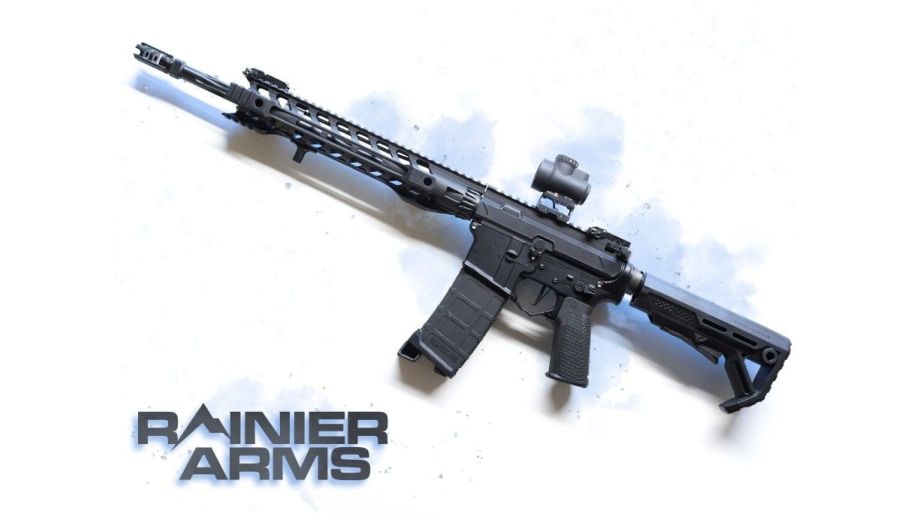AR15: Complete Buyers Guide
If you’re new to the firearm world, probably you have a lot of questions like which gun to buy, what are the prices, best practices, etc.
And the probability you’ve been suggested to buy AR15 is high as it’s one of the most popular firearms among Americans.
As the AR15 rifle can be quite complicated, especially at the beginning of the firearm journey, through this AR15 guide we will give our best to cover as many details as possible, explain how this rifle works, its parts, and many other questions.
Let’s dive in.
Why do people love AR15 so much?
The AR15 is not just any rifle - it's an American icon with an irresistible allure that has captured the hearts of gun enthusiasts nationwide.
Developed by Eugene Stoner back in the 1950s, this firearm's reputation for versatility, performance, and reliability has only grown stronger over time.
After the US military adopted it as the M16 rifle, the AR15 quickly became a household name, and its popularity has yet to show any signs of slowing down.
Table of contents
- How does an AR15 rifle work?
- Buy or build an AR-15, which is better?
- Parts of AR-15 rifle
- Complete systems
- Tools needed to build AR15
- Laws and Restrictions
- Conclusion
- Frequently Asked Questions
How does an AR15 rifle work?
Let’s break down how an AR15 rifle works.
When you pull the trigger, the firing pin strikes the primer on the back of the cartridge, causing it to ignite. This explosion creates high-pressure gas that drives the bullet out of the cartridge and down the barrel.
At the same time, some of this gas is tapped off and directed back into the gas tube, which runs down the length of the barrel and into the gas key on the bolt carrier group.
The gas pressure pushes the bolt carrier group backward causing the bolt to unlock from the barrel and extract the casing from the camber.
As the bolt carrier group moves to the rear it compresses the recoil spring which pushes the bolt carrier group back forward. That way, the bolt picks up a new round from the magazine and chambers it into the barrel.
Buy or build an AR-15, what is better?
What makes this gun so appealing is its versatility, allowing for a plethora of customization options.
Because of this, lots of people, especially newcomers, often wonder which option is best when it comes to the AR15 rifle, to buy or to build one.
As with any choice, though, there are advantages and disadvantages to consider. So, let’s dive in and take a closer look.
Buying a complete AR-15
List of reasons to buy a complete AR-15 rifle if you’re not comfortable with building one.
Convenience
You don’t have to worry about compatibility issues and if the parts fit together. Just load up your rifle and shoot.
Quality
Complete AR15 rifles come from well-known and established brands in the market.
Warranty
Complete AR15 rifles come with a warranty that covers any possible defects on the rifle.
Building AR-15
If, however, you decide to build your own AR15 rifle, then here’s the list of benefits.
Customization
When building the AR-15 from scratch, you’re the one determining the customization limits. From the rifle stock to the end of a barrel, you’re responsible for each part you assemble.
Cost-effective
With proper research of parts and manufacturers, you can build AR15 for less money than you would usually spend on buying a complete rifle.
Experience
Building the rifle from scratch can be a very interesting experience especially after you fire the first round knowing you’re the one who assembled each part of it.
If you want to proceed with building an AR-15 rifle on your own, continue reading to see which parts the AR-15 is made of.
Parts of AR-15 rifle
If you’re new to the rifle world, you can get the impression every rifle is very complex and be confused about how it works.
The AR15 can be split into two main parts: the upper receiver and the lower receiver.
Upper receiver
This is the top part of the rifle. Let’s say it contains all parts of the rifle responsible for its functioning.
It contains the next parts: barrel, gas system, bolt carrier group, charging handle, handguard, forward assist, and sight (or optic).
Barrel

Rainier Arms Mountain MOD2 5.56 NATO Barrel
The barrel is a long metal tube made of high-quality steel and it’s responsible for the rifle’s accuracy and reliability.
It contains a series of grooves on the inside which is called rifling that’s responsible for giving the bullet a spin as it travels through the barrel. Also, barrel length affects the muzzle velocity.
Read more:
- Choosing the Best AR-15 Barrel for Your Next Build
- What's the best 300BLK barrel length?
- The Top 10 Muzzle Devices for AR15 Rifles
Gas system
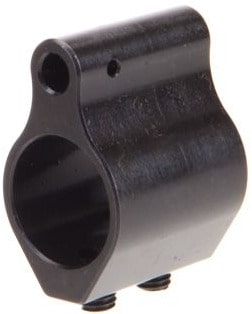
Cross Machine Tool (CMT) Tactical J.A.G. Gas Block
When you pull the trigger, you let out a blast of gas that gets captured by the system. That gas then goes to work pushing the bolt carrier group back, so it can eject the spent shell casing and get a new round ready to shoot again.
Read more:
Bolt carrier group
The bolt carrier group is responsible for cycling the rounds, extracting sent casings, and feeding new cartridges into the chamber of the AR-15 semi-automatic rifle.

Faxon Firearms Gunner BCG Ultra-Light Bolt Carrier Groups
It’s made of four main parts:
- Bolt that connects to the barrel to hold the bullet in place before it's fired. It also helps to take out the old bullet casing and put a new bullet from the magazine into the gun's chamber.
- The carrier holds the bolt and moves it back and forth when you shoot.
- The gas key works with the gas tube to cycle the bullets through the gun.
- Firing pin that hits the bullet so it'll go off and shoot out of the gun.
Read more:
Charging handle
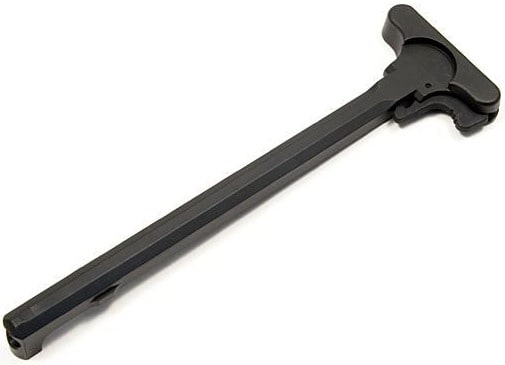
Charging Handle MIL-SPEC - AR-15
The charging handle is super important for getting the AR-15 rifle ready to shoot.
When you pull it back, the bolt carrier group goes back too, so it can take out the old shell and put in a new bullet. That way, the gun is ready to fire again.
The charging handle makes sure everything works the way it should, so you can rely on the gun to shoot when you need it to.
Read more:
Handguard

V Seven Weapon Systems AR-15 Enlightened M-LOK Handguard
The handguard is a part of the AR-15 rifle that's located near the front of the gun. It keeps the shooter’s hand safe from the barrel heat generated by long-session shooting.
Plus, it's a good surface to hold onto the rifle and it lets you attach other stuff like lights, lasers, and grips to make shooting easier.
Read more:
Forward assist
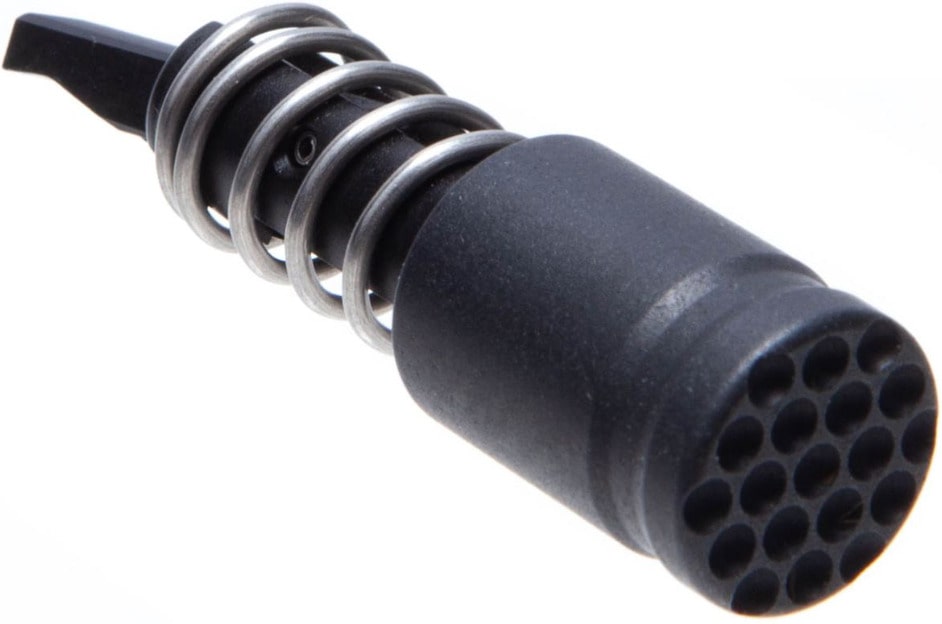
Forward Controls Design LDFA - Low Drag Forward Assist - Dimpled
A button-like part located on the upper receiver is used to push the bolt carrier group into place in case it doesn’t fully lock on its own.
This usually happens when there’s dirt, sand, or other debris in the gun.
By pressing the forward assist, you can ensure that the bolt carrier group is fully seated, which helps the rifle fire properly.
Read more:
Sight
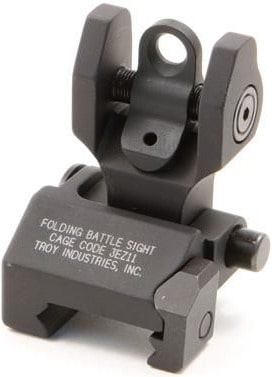
Troy Industries Rear Folding BattleSight - Tritium
The sights and optics on an AR-15 are what help you aim your shots.
When it comes to aiming your AR-15, you've got a couple of options. The classic choice is using iron sights, which are built into the rifle but nowadays, many folks are upgrading to red dot sights because they're quicker to use and can help you lock onto targets faster.
There are also fancy optics like scopes, but those can get pretty pricey. So, it's all about what you like and what you can afford.
Read more:
Lower receiver
The lower receiver part houses trigger assembly, a magazine well, and a buffer system. It’s the lower part of the rifle’s frame and is responsible for holding all of the rifle’s working parts in place.
Read more:
Trigger assembly
The trigger assembly is responsible for releasing the hammer which strikes the firing pin and ignites the primer. In short, the rifle fires.
It is made of several parts assembled: trigger, hammer, disconnector, and springs.
Each of these parts has its function in trigger assembly: the trigger is the part that the shooter is pressing, the hammer strikes the firing pin, firing pin hits the bullet. The disconnector resets the trigger after each shot.
Magazine well
The name says it all. Magazine well (or magwell) is responsible for securing the magazine stays in place.
Besides holding the magazine in place, magwell improves the ergonomics and user-friendliness of the rifle, while poorly designed magwell can make it difficult to reload the firearm smoothly.
Read more:
Bolt catch
The bolt catch helps the shooter to lock the bolt open after the last round has been fired.
When the last round is fired, the bolt catch will engage and hold the bolt open, indicating that the rifle is empty. This allows the shooter to quickly and easily reload the rifle without manually locking the bolt back.
Safety selector
The safety selector is located on the left side of the lower receiver and has two positions: safe and semi-auto while military weapons have the third option - automatic fire.
Pistol grip
Well again, the name says it all. The pistol grip allows the shooter to hold the rifle and is located just behind the trigger.
A pistol grip is a very important part of the AR15 as it allows the shooter to better control the rifle.
Buffer system
The buffer system is located in the rifle’s stock and is made of three parts: buffer, buffer tube, and buffer spring.
The buffer spring is responsible for regulating the bolt carrier group moving while firing and cycling.
When the rifle is fired, the bolt carrier group moves backward compressing the buffer spring. The buffer spring then pushes the bolt carrier group back in the first position and pushes the new round into the barrel.
Buffer system also reduces the rifle recoil.
Complete systems
If you’re looking for a faster way of building the AR15 rifle without buying each part separately, you can do it by buying prebuilt complete parts: complete upper receiver or complete lower receiver.
This is the easier way to build AR15 as complete parts contain almost everything you need to build a complete rifle. You just have attached them with two large pins known as “takedown” pins.
The complete upper receiver includes:
- Barrel
- Handguard
- Gas system
- Bolt carrier group
- Charging handle
- Forward assist
- Ejection port cover
- Iron sight
Read more:
The complete lower receiver includes:
- Trigger group
- Pistol grip
- Magazine release
- Buffer tube
- Stock
Tools needed to build AR15
Because of the rifle’s complexity, you will need various tools to assemble all parts you’ve bought. Another reason to use all these tools is to make sure the rifle is properly assembled and safe to use.
Assembling the weapon without tools may lead to misalignment of parts, improperly torqued fasteners, or other critical errors, especially if you’re a beginner.
- Armorer’s wrench - used to tighten and loosen the castle nut on the buffer tube and to install or remove the barrel nut.
- Torque wrench - used to ensure the proper torque settings on various parts like barrel nut and receiver extension.
- Punch set - required to drive out pins and detents like takedown pins and trigger pins.
- Vise and vise block - vise is used to secure the receiver while vise block is used to hold the receiver in place.
- Hammer - it’s used to tap the pins and detents.
- Screwdrivers - required to tighten various screws on a certain part like grip and stock.
- Upper and lower receiver vice blocks - these blocks are used to secure the upper and lower receiver.
- Gas block and gas tube alignment tools - necessary for installing the gas block and gas tube.
- Barrel nut wrench - required for installation or removal of the barrel nut.
- Barrel vise - used to securely hold the barrel in place while installing the barrel nut.
- Cleaning tools - not essential for building, but important for maintaining the rile later on.
More experienced shooters can assemble the whole rifle only without using the full list of tools from the above. However, we suggest getting all the necessary tools from the above list as they will help you properly assemble the rifle.
Laws and Restrictions
Building an AR15 rifle is legal, however, each state has its regulations regarding the specific accessories, firearms, and others.
So if you’re unsure about federal laws, the best thing to do is to consult a firearms lawyer or licensed firearms dealer.
Conclusion
We came to an end. We hope you have at least some beginner-level knowledge about AR15 rifles that will help you create the first steps in this journey.
Of course, you will gain more knowledge as time passes and start building or customizing your rifle according to your preferences.
Read more:
Frequently Asked Questions
Are AR15 rifles legal in my state?
The AR15 rifles are legal to purchase in the United States although these rifles were banned for ten years: from 1994 to 2004.
Can I use .223 Remington and 5.56 NATO interchangeably in an AR15?
Despite being very similar rounds, you shouldn’t interchangeably use these rounds as they can affect the rifle's performance or in some cases damage the rifle and injure you.
The main difference is in the pressure these rounds make: 5.56 NATO has higher pressure than the .223 Remington bullet.
What is the difference between a lower receiver and an upper receiver?
Although they are both part of the AR15 rifle, they are still two separate parts that can be customized separately.
Because of this, you can customize the weapon according to your needs.
Also, it’s good to know that the lower receiver is serialized part of the rifle meaning it’s registered with ATF and is subject to federal regulations.
Can I mix and match AR15 parts from different manufacturers?
It’s possible as long as those parts are compatible with each other. However, if you’re unsure of the compatibility of certain parts, contact manufacturers for more information to make sure the parts you bought are compatible together.
What is the best way to ensure my AR15 build is legal and compliant with federal and state laws?
The best way to be sure you’re doing everything by the law is to start by educating yourself about regulations in your state. Also, you can consult a firearms attorney as they can advise you on everything you need to know about registering your firearm.
Additional Reading
...

